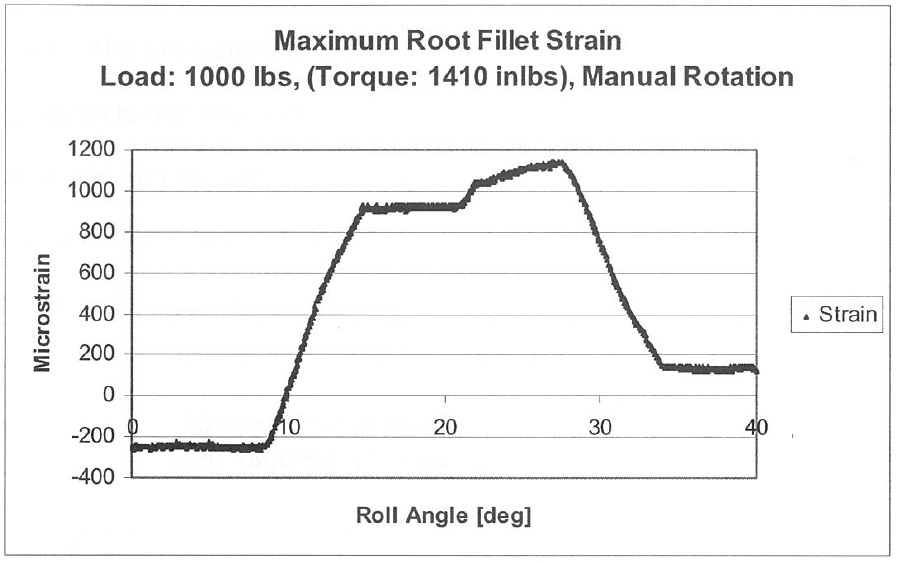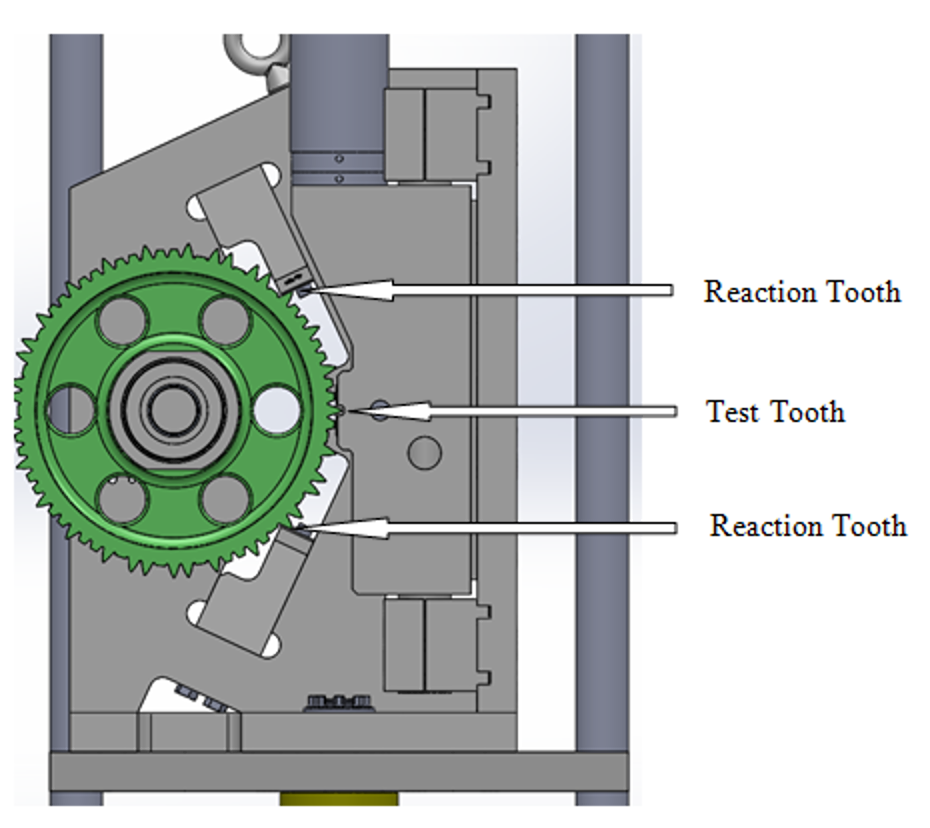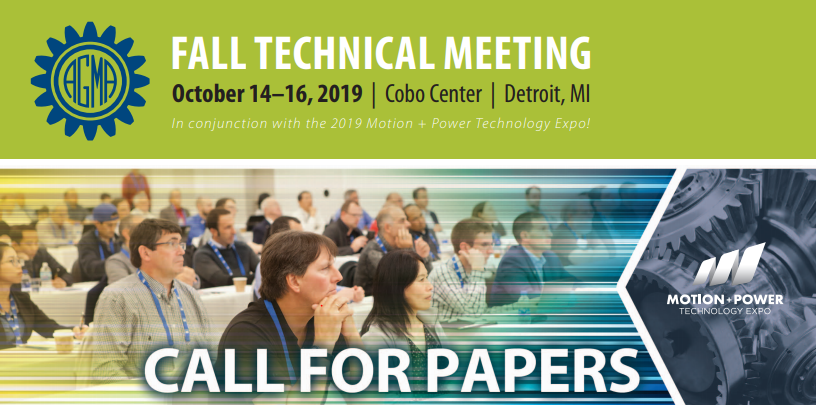Apr 2019 Newsletter - Transmissions Vol 23, 2019
 Vol. 23, Spring 2019
Vol. 23, Spring 2019
Foreward
In the early days of the Gear Research Institute, Caterpillar Inc. was much more involved in the testing and research activities that occurred within the institute. If you ever have an opportunity to tour the existing facility located within Penn States’ ARL, you will see test stands that still bear the Caterpillar inventory tags. Since the move in 1996, Caterpillar Inc. has kept most testing in-house, advancing independently. However, we have found an opportunity to collaborate once again, fulfilling our mission to provide and supplement gear and related technological needs by conducting research and development, consulting, analysis and testing.
In this newsletter, the project described has changed that. Single tooth bending fatigue benches are common within the Caterpillar test facilities, and this project’s budget could only afford that type of test. In theory a “Single Tooth Reverse Bending Fatigue” test could provide the data needed with the potential to have the same affordability of the STBF test, but a rig like this is not common. This provided a platform to reach outside for help. With this project, I have had the opportunity to get involved in assisting the customer (the company for which I work) fulfil a testing need, ensuring that project deliverables could be met, and witnessed the test rig grow from a concept to a working solution. It has been a perfect opportunity to observe the Gear Research Institute doing their part in advancing gear technology. The GRI can do this for the individual who want to test a theory, or in this case for a Fortune 500 company who needs additional resources.
Geary Smith
Engineering Manager, Mechanical Components
Innovation and Technology Development Division
Caterpillar

Research Project
Often considered the most catastrophic failure a gear can experience is a bending fatigue failure in the root region of the tooth where bending stresses are the highest. Consequently, evaluation of the bending fatigue performance (stress to life relationship) of various gear materials subject to various manufacturing processes is of significance to gear and transmission designers. The Gear Research Institute has been in the business of evaluating the bending fatigue performance of gears for many decades.
The conventional test for establishing the bending fatigue performance has been the Single Tooth Bending Fatigue (STBF) test as illustrated schematically in figure 1.

Figure 1: Schematic representation of an STBF test
The test gear is mounted on a spindle in a test fixture and the gear teeth under test are held between two independent anvils (shown in blue). The entire fixture is placed in a universal test frame and the anvils are subjected to cyclical loading until tooth bending failure occurs or a run out limit (predetermined number of cycles without failure) is reached. The bending stress the test teeth were subject to and the number of cycles to failure are the relevant data. This test is easy to implement and relatively inexpensive as several teeth on each gear can be tested to provide several data points with one test gear. However, one limitation in this test is that it is not directly representative of typical gear applications. The test load is unidirectional and the root areas of the two teeth under test are subject to tensile stresses only. There is no ability to load the test tooth root fillet in compression. It is well known that the root areas of gear teeth in mesh and transmitting power are subject to both tensile and compressive stresses. This is shown in Figure 2, which shows the output from a strain gage mounted at the root fillet of a gear tooth (under load) as it executes one mesh cycle. It first experiences compressive strain which then transitions to tensile to the maximum magnitude before it goes out of mesh.

Figure 2: Strain measurement at the tooth root fillet(1)
This inability to realistically simulate a tooth in mesh has relegated the STBF test to a comparative assessment role, when evaluating the relative performance of various gear materials and manufacturing processes. However gear engineers require bending fatigue data that more closely simulates actual gear teeth in mesh to establish the “allowable” stress levels for design purposes.
The solution to this drawback of the STBF test has always been to conduct rotating bending fatigue tests. This test is conducted in a power re-circulating (four-square or back-to-back) test rig where the bending stresses on the meshing gear teeth are identical to those in most real world applications. During testing the gears are operating under realistic power transmission conditions and the resulting bending fatigue data is directly applicable to the design of a gear. As one would expect, this is more labor intensive (i.e. expensive) than STBF testing. Further, four test gears are required for each test that may yield one or two data points, depending on the set up. Statistical confidence in the data may require many repetitions, further adding to the cost.
The Single Tooth Reverse Bending Fatigue (STRBF) test is shown schematically in figure 3. This new test provides a solution to this problem by applying bending stresses similar to those experienced by a meshing gear with the simplicity and low-cost characteristics of the STBF test. This set up involves three teeth of the test gear (shown in green), with the upper and lower teeth providing the reactions in the up and down load directions and the test tooth being subject to test loads in both directions. This arrangement allows the root fillet of test tooth to be subject to tensile and compressive bending stresses. The test frame can be programmed to vary the actual magnitude of the loads to be equal in the two directions or any fraction thereof. The ability to obtain several data points on one test gear makes this approach significantly more cost effective than the rotating gear test. A major project utilizing this approach for a single-client is currently underway.

Figure 3: Schematic representation of an STRBF test
Reference:
1: Schwanger, V.C., “Experimental Measurement of Dynamic Bending Stresses at the Root Fillet of Spur Gear Teeth”, A thesis in Industrial Engineering, Penn State, 2003.
Education and Training
In order to assist with replenishment of the gear industry’s aging work force, the Gear Research Institute has developed a hands-on education program for students at both undergraduate and graduate levels. The results of the program are entry level engineers that have been trained in the basics of gearing. This involves incorporating engineering undergraduate students, at the junior/senior level and graduate students in the Institute’s research laboratory while being paid by a grant from the sponsoring industrial entity. Summer internships have also been arranged at the sponsor’s facility, so that the student and the sponsor have an opportunity to assess each other with future employment in mind.
Typically, students get hands on experience by setting up and monitoring gear test equipment with additional training topics such as gear metrology, failure analysis is, metallurgical characterization, vibration monitoring for failure detection, statistical analysis of test data and more.
This newsletter’s student profile is of Cody Wassel. Cody graduated from Penn State (B.S., Mech. Eng.) in May of 2018 and is currently pursuing his Master of Science degree in Mechanical Engineering. Cody is supported on a graduate assistantship jointly funded by the Army, Navy and NASA through a Vertical Lift Research Center of Excellence (VLRCOE) program task. Cody’s research focus is on the failure mechanisms of carburized aerospace gears steels during loss of lubrication events. He is on track to graduate in May 2020.

For more information about how you can support a student intern or sponsor a student project, please visit www.gearresearch.org or contact Aaron Isaacson at 814 865 5832 or This email address is being protected from spambots. You need JavaScript enabled to view it..
Gear Industry Vision Workshop
Background
A six-month effort led by the Gear Research Institute, culminated in the “Gear Industry Vision 2025” workshop on March 10, 2004 in Detroit, Michigan. Attended by about 40 gear industry experts, the deliberations of this group were published as a report titled “Gear Industry Vision” and made widely available to participants and non-participants in the industry.
The workshop started with an overview of the industry in 2004 and then explored the trends and drivers anticipated to shape this industry sector into the year 2025. It then proceeded to define a vision for this industry by identifying Strategic Goals and the Grand Technology Challenges to meet these goals.
In hindsight (15 years later), a review of the Gear Industry Vision report reveals that many of the goals and technological challenges defined were prophetic. The critical trends and strategic goals defined in that report have all either occurred, or are still relevant and ongoing. From a purely technological perspective, the drive to increase performance of geared systems at lower costs have emphasized research thrusts into advanced steels and novel manufacturing processes. Thrusts in the strategic goal of increasing education and training in this field have been less successfully realized.
The key to another successful Vision workshop is the participation of experts in the gear industry. We seek your opinion whether another Vision workshop is warranted. It would involve a one day meeting, either in person or on the web and your follow-on input as the draft report summarizing this effort is finalized. Your interest in participating and even financially supporting such an activity is solicited.
Please respond to the following brief survey so that we may gauge interest in another Vision workshop: https://forms.gle/HvBVXH9pXx2bZbaK6
To receive a copy of the 2004 Gear Industry Vision report, please contact Aaron Isaacson at This email address is being protected from spambots. You need JavaScript enabled to view it. or 814-865-5832.
Potential Workshop on Polymer/Plastic Gears
In the last few years several industrial organizations in the business of polymer/plastic gears have approached the Gear Research Institute on the topic of evaluating the performance of gears fabricated from polymeric materials. In spite of the fact that polymer gears are being applied in many instances wGearhere metallic gears were once the norm, traditional gear related performance data on these materials is unavailable. The Gear Research Institute’s cooperative pre-competitive research model is an ideal platform to address this issue. A research group consisting of polymer material producers, polymer gear manufacturers and potential users could cooperatively fund such an effort so that the cost burden on any individual entity is not onerous. A steering committee, consisting of representatives from sponsoring companies, will direct the research effort as to how and what polymers will be evaluated. Once such data (which can be held proprietary to the research sponsors) is developed the potential for the insertion of polymer gears where metal gears are used exclusively, could be significant.
If such an activity is of interest to you or your organization, please contact Aaron Isaacson at This email address is being protected from spambots. You need JavaScript enabled to view it.. If sufficient interest exists, a workshop to explore potential research and testing topics will be planned.
News
It is with great sadness that we announce the death of yet another long-time friend of GRI. Thomy Bui of Honeywell was a member of the Aerospace Bloc Steering Committee for many years. He was one of the most engaged participants that the group has ever had. Thomy’s enthusiasm for life (and gears!) was contagious. He retired from Honeywell in September of 2016.
Thomy passed from natural causes at his home in Scottsdale, AZ on October 13, 2018. He was 63 years old.

GRI would like to encourage attendance at both the 2019 AGMA Fall Technical Meeting (Detroit, MI on October 14-16) and the VDI International Conference on Gears 2019 (Munich, Germany on September 18-20). Please click on the banners below for more information. Both are excellent conferences!
Employment Opportunities
We have added a “Job Postings” section to the GRI website for gear and drivetrain related positions. This service is offered free of charge to our Corporate members and sponsors. If you’re interested in having your company’s job openings listed, please contact Aaron Isaacson at This email address is being protected from spambots. You need JavaScript enabled to view it..
Please take a moment to check it out! http://gearresearch.org/job-postings.html.
The Gear Research Institute is a non profit corporation. It has contracted with the Applied Research Laboratory of The Pennsylvania State University to conduct its activities, as a sponsor within the Drivetrain Technology Center. The Gear Research Institute is equipped with extensive research capabilities. These include rolling contact fatigue (RCF) testers for low- and high-temperature roller testing, power circulating (PC) gear testers for parallel axis gears with a 4-inch center distance (testers can be modified to accommodate other center distances), single tooth fatigue (STF) testers for spur, helical and spiral bevel gears, and gear tooth impact tester. Extensive metallurgical characterization facilities are also available at Penn State in support of the Gear Research Institute. For further details on our testing capabilities please go to www.gearresearch.org or call Aaron Isaacson, Managing Director, at (814) 865-5832.


